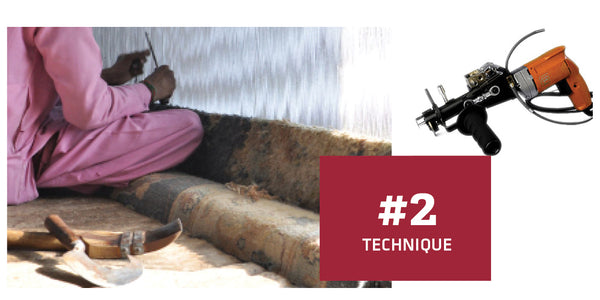- Continue Shopping
- Your Cart is Empty
Vintage or New? 5 Things to Consider

This question comes up a lot: What do I need to know when buying a vintage rug?
We decided to break it down in a side-by-side comparison of vintage and new production rugs.
We decided to break it down in a side-by-side comparison of vintage and new production rugs.

Vintage: While there are certain styles that are common to an area, you’re much more likely to find a unique or one-of-a-kind piece if it’s vintage.
New Production: New productions are typically produced in higher volumes and multiple sizes. This is useful when placing identical rugs throughout a space, not when you're looking for a rug that has singular character.

Vintage: Any rug that was made more than 30 years ago is almost guaranteed to be completely hand-knotted or hand-woven. For hand-woven rugs (like kilims), this usually translates to a production time of 3-4 months; for hand-knotted rugs, 9 months to 1 year.
New Production: Hand-knotted and hand-woven rugs are still produced today, with weaving centers specializing in specific designs and style. However, today, speed and cost pressures drive many rug manufacturers to produce machine-made or “hand-tufted” rugs. These rugs are lower quality and don’t hold up to wear very well, but have become more common due to their low prices.

Vintage: Vintage pieces usually have more traditional and tribal patterns and colors; however, they can be updated with new washes and colors. Often times, their colors may have changed over time, due to sun or the natural maturation of their vegetable-based dyes.
New Production: New production rugs run the gamut of styles, with traditional Persian, Turkish and Indian designs being produced alongside modern motifs. Colors can range from subtle and muted to nearly neon, and employ both vegetable and chrome dyes.

Vintage: Antiques and true heirlooms are often priced like fine art; more common vintage pieces are priced based on their supply and demand. They’re most affordable when they have visible wear and tear, or if their look is wildly out of style. (Pro Tip: We often stock a wide selection of affordable kilims that we supply directly from villages in Turkey.)
New Production: New rugs are very much influenced by market fluctuations around labor and material prices, and vary widely based on complexity of design, quality of materials, weaving technique and region where they were produced. Prices can range from a few hundred to thousands of dollars, though always be sure to compare SIZE as well, as that is the most influential factor in any rug's price.

Vintage: Some vintage pieces look almost new, while others have a more visibly worn look to them. Handmade vintage rugs can be washed and repaired; even if a vintage piece is 50 years old, it usually still has more life left in it than a newly-made hand-tufted or machine-made rug.
New Production: New hand-knotted and hand-woven rugs can be washed and repaired like vintage pieces. New production rugs that are NOT handmade — “hand-tufted” or machine-made — commonly have a rubber or adhesive backing that falls apart over time. These cannot be washed or repaired, so it's important you know what you're buying so you can factor in replacement costs in your selection. (Note: We don't carry hand-tufted or machine-made rugs, only truly handmade rugs.)
Featured Products
X






Erin Eisinger
Author
Floorplan CEO and Co-Founder. Designer. Storyteller. Entrepreneur.